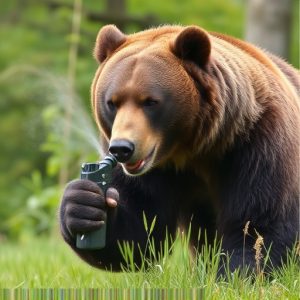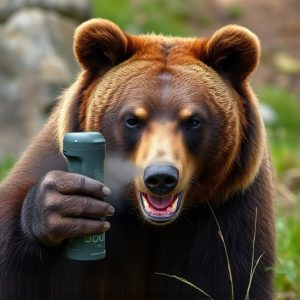Bear Spray Ingredients & Legal Limits: What You Need to Know
Bear spray, a powerful deterrent made from chili pepper extract, is a key tool for outdoor adventure…….
Bear spray, a powerful deterrent made from chili pepper extract, is a key tool for outdoor adventurers in bear country, but its use is strictly regulated. Local regulations and national park rules prohibit bear spray in certain areas to protect wildlife and ecosystems. Responsible users should check guidelines before visiting protected zones, where alternative deterrents like noise makers or physical barriers are recommended. Misuse or improper application of bear spray can lead to negative outcomes, emphasizing the importance of following local rules, especially regarding its storage.
“Bear spray, a powerful tool for self-defense in wildlife encounters, relies on key active ingredients like capsaicin oleoresin. This compound, derived from chili peppers, is known for its ability to deter bears. However, understanding the mechanics of bear spray goes beyond its components. This article explores the science behind capsaicin oleoresin, delves into legal restrictions regarding where bear spray is prohibited, and provides insights on responsible usage for maximum effectiveness and safety.”
- Understanding Bear Spray Ingredients: Capsaicin Oleoresin Explained
- Legal Considerations: Where Bear Spray is Prohibited
- Effectiveness and Safety: Using Bear Spray Responsibly
Understanding Bear Spray Ingredients: Capsaicin Oleoresin Explained
Bear spray, a vital tool for outdoor enthusiasts and survivalists, contains powerful active ingredients that deter aggressive bears. One such ingredient, Capsaicin Oleoresin, is at the forefront of this defense mechanism. This natural compound is derived from chili peppers, packing a punch that mimics the burning sensation of spicy food but on a much grander scale. It’s not just about the heat; capsicum oleoresin triggers a complex physiological response in animals, causing them to avoid the area due to intense irritation and pain.
Understanding the source and effects of this ingredient is crucial when considering bear spray as a protective measure. While it’s an effective deterrent for most bears, its use is not universal and varies based on location. In some areas, where wildlife management differs, or in regions with specific regulations regarding bear interactions, bear spray may be prohibited or strictly controlled. Therefore, being aware of local guidelines regarding bear spray is essential before venturing into wild territories.
Legal Considerations: Where Bear Spray is Prohibited
In many regions, bear spray is a widely accepted and legal tool for personal safety when encountering bears in their natural habitat. However, there are certain areas where its use is strictly prohibited due to varying legal frameworks and local regulations. National parks and wildlife reserves often have strict rules regarding bear deterrents, including bear spray, as they aim to protect both visitors and the native ecosystem. These restrictions are typically put in place to prevent potential harm to wildlife, maintain natural behaviors, or avoid introducing foreign substances into delicate ecosystems.
Understanding where bear spray is off-limits is crucial for responsible outdoor enthusiasts. It’s essential to check local guidelines before venturing into protected areas. Violating these prohibitions can result in fines and legal consequences, so being informed about the regulations specific to each location is vital. Additionally, knowing alternatives to bear spray, such as noise makers or physical barriers, ensures compliance with local laws while still maintaining a safe experience in bear country.
Effectiveness and Safety: Using Bear Spray Responsibly
Bear spray, a powerful deterrent, has become an essential tool for outdoor enthusiasts navigating bear country. Its effectiveness lies in its active ingredients, primarily capsaicin oleoresin, derived from chili peppers. This compound stimulates pain receptors, causing bears to recoil and create distance. Studies show that when used responsibly, bear spray can successfully deter aggressive encounters, providing a valuable safety measure in areas where bears are present.
However, it’s crucial to understand that bear spray is not foolproof. Misuse or improper application can lead to unfortunate outcomes. Always follow local guidelines; some regions have specific rules regarding its use and storage, especially in sensitive ecosystems where bears play a vital role. Additionally, bear spray shouldn’t be used as the sole method of protection. It’s essential to practice awareness, make noise while hiking, and carry other deterrents to ensure maximum safety when venturing into bear-inhabited areas, avoiding where it’s prohibited.
Bear spray, while a valuable tool for protecting against bear encounters, is subject to legal restrictions in certain areas. Understanding the active ingredients, notably capsaicin oleoresin, and practicing responsible usage are key to ensuring its effectiveness. Remember, knowing where bear spray is prohibited is crucial before embarking on outdoor adventures, as it can vary by region. By staying informed, you can better navigate the outdoors safely and responsibly.


